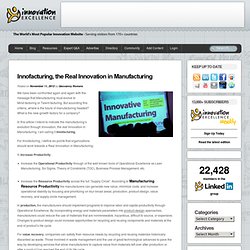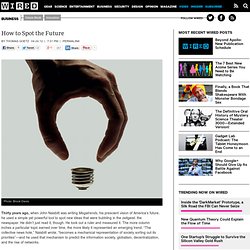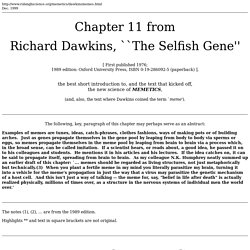

The Rising Silver Tide: Aging as Counter Current to Innovation. Six Simple Rules For Doing Better With Less. Innofacturing, the Real Innovation in Manufacturing. We have been confronted again and again with the message that Manufacturing must evolve to Mind-facturing or Talent-facturing.

But according this criteria, where is the future of manufacturing headed? What is the new-growth factory for a company? In this article I intend to indicate the manufacturing’s evolution through Innovation, the real Innovation in Manufacturing. I am calling it Innofacturing. For Innofacturing, I define six points that organizations should work towards a Real Innovation in Manufacturing: 1.
Increase the Operational Productivity through of the well known tools of Operational Excellence as Lean Manufacturing, Six Sigma, Theory of Constraints (TOC), Business Process Management, etc.Increase the Resource Productivity across the full “Supply Circle”. In production, the manufacturers should implement programs to improve labor and capital productivity through Operational Excellence. 2. 3.
How the manufacturers turn “ordinary” employees into extraordinary innovators? 4. Crystal light methods. *Alistair A.R.

Cockburn*Humans and Technology (from Cutter IT Journal, 2001) In the early 1990’s, Alistair Cockburn was hired by the IBM Consulting Group to construct and document a methodology for object-oriented development. They had no preferences as to what the answer might look like, just that it work. His approach to the assignment was to interview as many projects as possible, writing down whatever the teams said was important to their success (or failure). Team after successful team “apologized” for not following a formal process, for not using a hi-tech CASE tool, for “merely” sitting close to each other and discussing as they went. Ford CTO Paul Mascarenas On Bridging The Worlds Of Silicon Valley And Motor City [TCTV]
Combinatorial Creativity and the Myth of Originality. How to Spot the Future. Photo: Brock Davis Thirty years ago, when John Naisbitt was writing Megatrends, his prescient vision of America’s future, he used a simple yet powerful tool to spot new ideas that were bubbling in the zeitgeist: the newspaper.

He didn’t just read it, though. He took out a ruler and measured it. The more column inches a particular topic earned over time, the more likely it represented an emerging trend. “The collective news hole,” Naisbitt wrote, “becomes a mechanical representation of society sorting out its priorities”—and he used that mechanism to predict the information society, globalism, decentralization, and the rise of networks. As clever as Naisbitt’s method was, it would never work today. This may sound like a paradox. So how do we spot the future—and how might you? It’s no secret that the best ideas—the ones with the most impact and longevity—are transferable; an innovation in one industry can be exported to transform another. This notion goes way back. How to Spot the Future. How Your Brain Avoids Mental Traffic Jams - Brian Fung - Health.
To keep from tripping over one another, different parts of your brain run at different speeds.

Flickr/andrew_bisset We often like to think of our brains as a single device, the unitary executive governing the republic of our limbs and thoughts. While there's some truth to that, the reality is much more complex. In fact, not only do different parts of the brain perform different functions, but many of our basic activities -- such as quoting a song lyric or calculating a waiter's tip -- actually activate multiple regions of the brain that fire in perfect coordination with one another. When these otherwise independent parts of the brain work together, they operate in what's called a brain network: Large scale brain network research suggests that cognitive functioning is the result of interactions or communication between different brain systems distributed throughout the brain. A 5-Step Technique for Producing Ideas circa 1939.
``Memes, The New Replicators'' Dec. 1999 Chapter 11 from Richard Dawkins, ``The Selfish Gene'' [ First published 1976; 1989 edition: Oxford University Press, ISBN 0-19-286092-5 (paperback) ], the best short introduction to, and the text that kicked off, the new science of MEMETICS, (and, also, the text where Dawkins coined the term `meme').

The following, key, paragraph of this chapter may perhaps serve as an abstract: Examples of memes are tunes, ideas, catch-phrases, clothes fashions, ways of making pots or of building arches. The notes (1), (2), ... are from the 1989 edition. Highlights ** and text in square brackets are not original. 11. So far, I have not talked much about man in particular, though I have not deliberately excluded him either.
Most of what is unusual about man can be summed up in one word: `culture'. Cultural transmission is not unique to man. Song in the saddleback truly evolves by non-genetic means. The dirty secret behind the incubator boom. “It’s people.

Soylent Green is made out of people. They’re making our food out of people. Next thing they’ll be breeding us like cattle for food.”